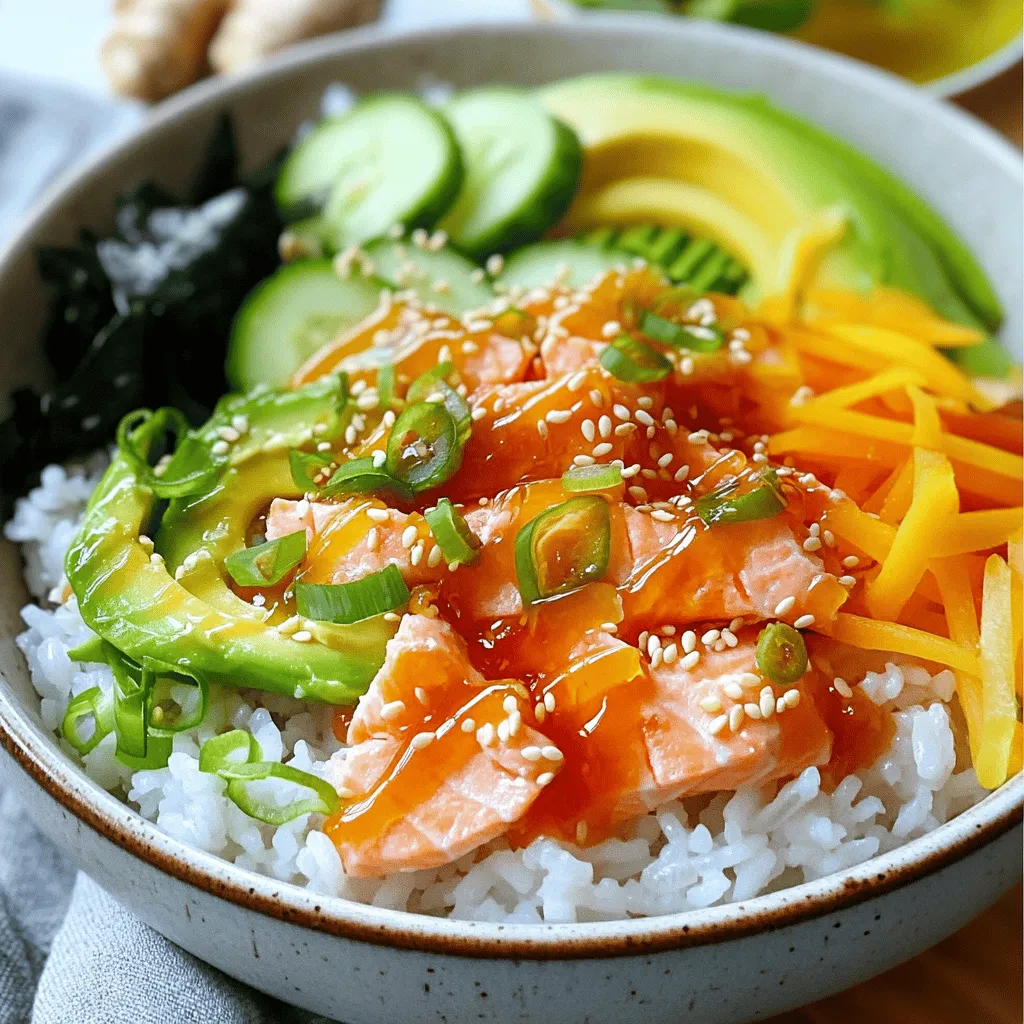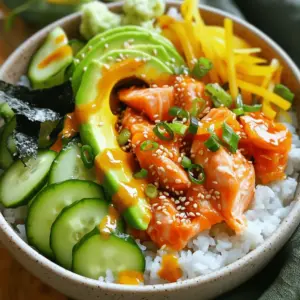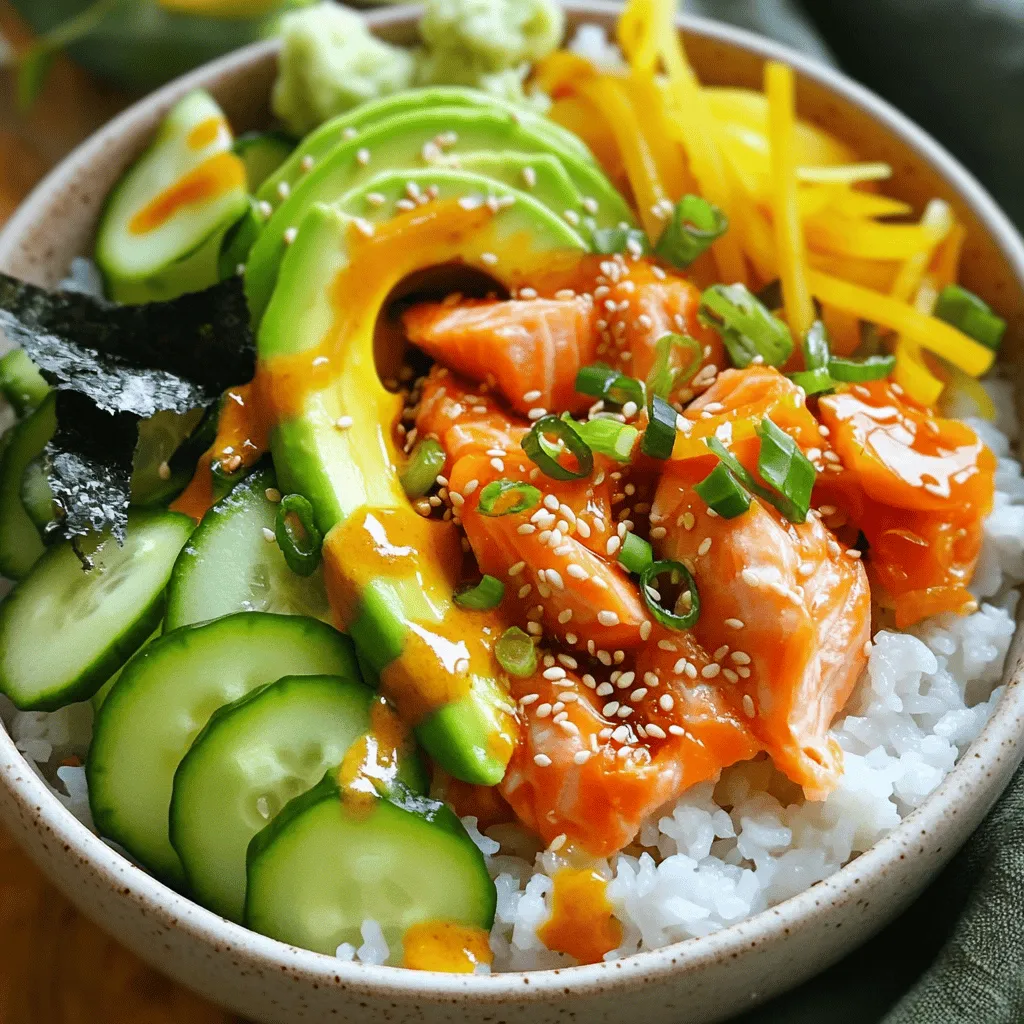Looking for a quick, tasty meal? The Minute TikTok Salmon Rice Bowl is perfect! It combines fresh salmon, fluffy sushi rice, and vibrant veggies into a delightful dish. You’ll enjoy every bite while impressing your friends with your culinary skills. Get ready to whip this up in minutes! Let’s dive into the ingredients and steps you need to create this winning recipe today!
Ingredients
Main Ingredients
– 1 cup sushi rice
– 1 fresh salmon fillet (about 6 oz)
– ½ avocado, sliced
– 1 small cucumber, julienned
Seasonings and Garnishes
– 1 tablespoon rice vinegar
– 1 teaspoon soy sauce (or tamari for gluten-free)
– 1 teaspoon sesame oil
– 1 tablespoon pickled ginger
Optional Add-ons
– Seaweed sheets (for garnish)
– 1 teaspoon sesame seeds
– 2 green onions, sliced
To make this Minute TikTok Salmon Rice Bowl, use fresh and quality ingredients. Sushi rice forms the base of the dish. It is sticky and perfect for holding the toppings. The salmon fillet is key. It gives a rich flavor and healthy fats. Avocado adds creaminess and cucumber adds a nice crunch.
For seasonings, rice vinegar adds a tangy taste. Soy sauce enhances the flavor with saltiness. Sesame oil brings a nutty note. Pickled ginger gives a bright zing to the dish.
You can also add seaweed sheets for texture. Sesame seeds give a nice crunch too. Green onions add a pop of color and a mild onion taste. These ingredients make your bowl exciting and tasty!
Step-by-Step Instructions
Preparing the Sushi Rice
Rinsing the rice
First, rinse the sushi rice under cold water. Do this until the water runs clear. This step removes excess starch and helps the rice become fluffy.
Cooking the rice
In a medium saucepan, combine the rinsed rice and 1 ½ cups of water. Bring this to a boil. Once boiling, reduce the heat to low. Cover the pan and let it simmer for 15 minutes. After that, turn off the heat. Let it sit covered for another 10 minutes.
Flavoring the rice
In a small bowl, mix 1 tablespoon of rice vinegar, 1 teaspoon of sugar, and ½ teaspoon of salt. Stir until it dissolves. Gently fold this mixture into the cooked rice. Let it cool slightly before using.
Cooking the Salmon
Searing the salmon fillet
While the rice cools, heat a non-stick skillet over medium heat. Lightly sear the salmon fillet for 2-3 minutes on each side. Cook it until it is just done or to your liking.
Achieving desired doneness
Keep an eye on the salmon as it cooks. If you prefer it less cooked, reduce the cooking time. For well-done, increase it slightly.
Flaking the salmon
After cooking, remove the salmon from the heat. Use a fork to flake the salmon into bite-sized pieces. This makes it easy to layer in the bowl.
Assembling the Rice Bowl
Layering the ingredients
Grab a serving bowl and spoon a generous portion of sushi rice as the base. Add the flaked salmon on top of the rice.
Drizzling sauces
Next, drizzle 1 teaspoon of soy sauce and 1 teaspoon of sesame oil over the top. This adds great flavor to the dish.
Adding garnishes
Finish off the bowl with sliced avocado, julienned cucumber, and pickled ginger. Sprinkle sesame seeds and sliced green onions as garnishes. For extra crunch, add torn seaweed sheets around the bowl. Enjoy your delicious creation!
Tips & Tricks
Perfecting Sushi Rice
To get the right texture for sushi rice, rinse it well. Rinse until the water runs clear. This step removes excess starch. It helps the rice be less sticky. After rinsing, use 1 cup of rice to 1 ½ cups of water. Cook it on low heat for perfect results. Let it sit covered for 10 minutes after cooking. This makes the rice fluffy and soft. If you can’t find sushi rice, use short-grain rice. It will still give you a great texture.
Cooking Salmon to Perfection
When searing salmon, keep the heat medium. This helps cook it evenly. Sear for 2-3 minutes on each side. If you like it less cooked, check it earlier. For alternative cooking methods, you can grill or bake the salmon. Grilling adds a nice smoky flavor. Baking helps keep it moist. Both options are tasty and easy.
Presentation Ideas
To make your bowl look good, arrange the ingredients neatly. Start with a base of rice. Then, add the salmon and veggies on top. Use vibrant colors like green avocado and bright cucumber. This adds visual appeal. For a final touch, sprinkle sesame seeds and add seaweed sheets. These details make the dish pop and taste even better.

Variations
Protein Options
You can easily swap out the salmon. Tuna works well for a fresh taste. Shrimp is another great choice for a quick meal. If you want a vegetarian option, try marinated tofu. It soaks up flavors nicely and adds protein.
Flavor Enhancements
To kick up the heat, add spicy mayo or a touch of wasabi. Both give a nice zing to your bowl. You can also mix in different vegetables. Carrots, bell peppers, or radishes add crunch and color.
Serving Suggestions
Pair your rice bowl with miso soup for a warm side. Edamame also makes a great addition for snacks. For a fun twist, serve it as a sushi platter. Guests will love mixing and matching flavors at the table.
Storage Information
Storing Leftovers
To keep your salmon rice bowl fresh, refrigerate it right after eating. Place leftovers in an airtight container. This helps prevent the rice from drying out. The bowl stays good in the fridge for about two days.
For best results, separate the salmon from the rice and veggies. This keeps everything fresh and tasty. Use glass or BPA-free plastic containers for storage. They are safe and easy to clean.
Reheating Tips
When you’re ready to eat your leftovers, reheating rice can be tricky. The best method is to use a microwave. Add a splash of water to the rice before reheating. Cover it with a damp paper towel. This helps steam the rice and keeps it moist.
For the salmon, reheat it gently in a skillet. Heat on low for about two minutes. This keeps the salmon’s texture nice. Avoid using high heat, as it can make the fish dry.
Freezing Recommendations
You can freeze the salmon rice bowl, but it’s best to freeze the parts separately. Cooked rice and salmon freeze well, while fresh veggies do not. When you’re ready to eat, thaw the rice and salmon in the fridge overnight.
After thawing, reheat the rice as mentioned above. This way, you enjoy a fresh and tasty meal!
FAQs
What type of rice is best for sushi?
Sushi rice is special. It is short-grain rice that gets sticky when cooked. This stickiness helps the rice hold together. If you cannot find sushi rice, you can use short-grain white rice. Brown rice is another option, but it will change the texture and taste a bit. Rinse any rice you use to remove extra starch. This helps your rice stay fluffy.
How to make a salmon rice bowl gluten-free?
To make your salmon rice bowl gluten-free, swap out regular soy sauce for tamari. Tamari is a gluten-free soy sauce. You can also check the ingredients of other items, like rice vinegar and sesame oil, to ensure they are gluten-free. Also, be careful with garnishes and toppings. Many pickled ginger brands are gluten-free, but always check the label.
Can I use cooked salmon?
Yes, you can use cooked salmon. If you have leftover salmon, it is perfect for this bowl. Just flake the cooked salmon into pieces. Store your cooked salmon in the fridge for up to three days. Keep it in an airtight container to keep it fresh. If you want to use frozen salmon, thaw it overnight in the fridge before using.
This blog showed you how to create a fresh salmon rice bowl. You learned about key ingredients like sushi rice, salmon, and avocado. We covered step-by-step instructions for preparing, cooking, and assembling the dish. Tips helped perfect the rice and salmon, while variations gave you options. Finally, we discussed storage and reheating for leftovers. Enjoy making this dish that’s easy, tasty, and great for sharing!

